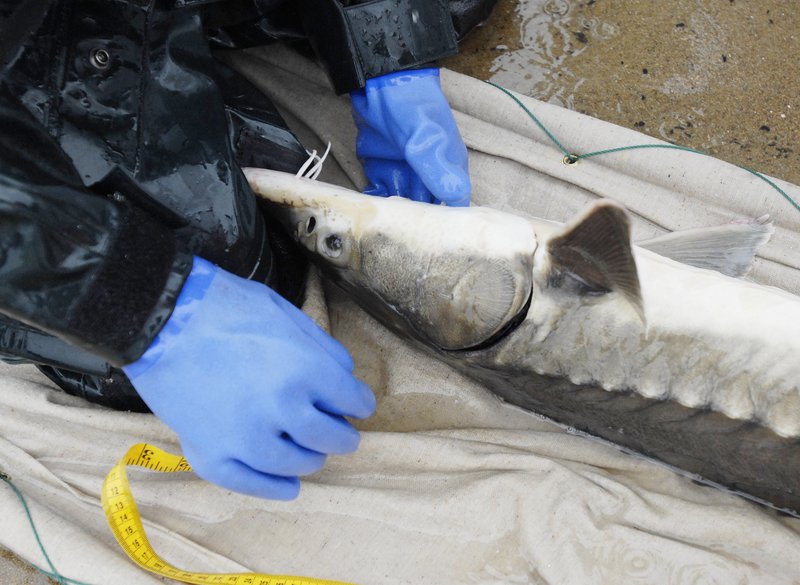BOSTON – The health of the ancient Atlantic sturgeon has emerged as the latest problem for a New England fishing industry already facing serious threats to its future.
On Wednesday, regional fishery managers discussed protecting sturgeon, two months after federal officials listed the fish in the Gulf of Maine as “threatened” under the Endangered Species Act. Four other East Coast populations of the imposing, prehistoric fish were listed as the more serious “endangered” at that time.
Fishermen are forbidden from targeting sturgeon, but the listings could still lead to tough new fishing restrictions, such as closing new areas. That could happen if regulators determine so many sturgeon would be accidentally caught by fishermen chasing other species that it would jeopardize the sturgeon’s existence.
The prospect of more restrictions comes as fishermen in the Gulf of Maine face a 22 percent cut in the catch of the key cod species in May, with potentially catastrophic cod cuts looming in 2013.
They’re also getting shut out of a prime pollock area for two months, starting in October, to protect harbor porpoises.
On Wednesday, David Pierce of the New England Fishery Management Council predicted that new regulations would be needed to protect sturgeon and would cause “untold grief” for fishermen from New England down to the mid-Atlantic states.
He made a proposal, which the council approved, that requires a council committee to assess the federal science behind the listing itself and find out how researchers arrived at the low population estimates for sturgeon.
Council member Laura Ramsden said population estimates for Atlantic sturgeon were unreliable because the last comprehensive assessment was conducted more than a decade ago. She also questioned why onerous restrictions were needed, since only a minority of sturgeon that have contact with fishing gear end up dying from it.
“I’m not sure that’s justified,” she said.
But Kim Damon-Randall of the National Oceanic and Atmospheric Administration said regulators have more recent, solid estimates of the sturgeon population, and they show the population can’t afford even a few deaths.
“We’re talking about very low population sizes so even a small percentage being removed each year is a significant number of Atlantic sturgeon,” she said.
The sturdy fish, found from Florida to Maine, can grow as large as 14 feet and 800 pounds and live for 60 years. They spawn in rivers in the spring and early summer, then head for open water. The once-abundant fish was depleted in the late 19th century by demand for their caviar.
Now, federal regulators estimate there are roughly 8,200 sturgeon vulnerable to fishing gear (not counting younger, smaller fish), including 664 in the Gulf of Maine.
Regulators say the sturgeon is most endangered by stationary nets that sink to the bottom, so-called sink gillnets. The gear is often used by fishermen targeting monkfish, but it’s also used to catch other species such as cod and dogfish. Regulators estimate about 27 percent of the sturgeon that encounter sink gillnets end up dying.
Ron Smolowitz, of the Fisheries Survival Fund, a scallop industry group, warned the council that restrictions to protect the fish could affect many fishermen who don’t use sink gillnets. Under the Endangered Species Act, certain areas can be designated as “critical habitat” if those areas are seen as essential to conserving the species.
Such critical habitat designations can come with restrictions that “could wipe out the entire fisheries of the East Coast of the United States,” he said.
Brad Sewell, an attorney for the National Resources Defense Council, which petitioned to have the sturgeon listed under the Endangered Species Act, said in a phone interview said it’s extremely unlikely new sturgeon restrictions will have such a broad effect.
Changes to sink gillnet fishing will be the focus, and there are affordable, sensible measures can make it less of a danger to sturgeon, such as pulling up the nets more often or raising them off the ocean floor to avoid sturgeon, he said.
“We’re confident that there are cost-effective ways of saving this remarkable fish and also keeping fishermen on the water,” Sewell said.
Send questions/comments to the editors.



Success. Please wait for the page to reload. If the page does not reload within 5 seconds, please refresh the page.
Enter your email and password to access comments.
Hi, to comment on stories you must . This profile is in addition to your subscription and website login.
Already have a commenting profile? .
Invalid username/password.
Please check your email to confirm and complete your registration.
Only subscribers are eligible to post comments. Please subscribe or login first for digital access. Here’s why.
Use the form below to reset your password. When you've submitted your account email, we will send an email with a reset code.